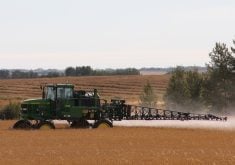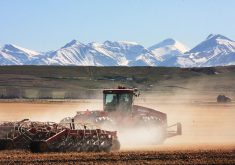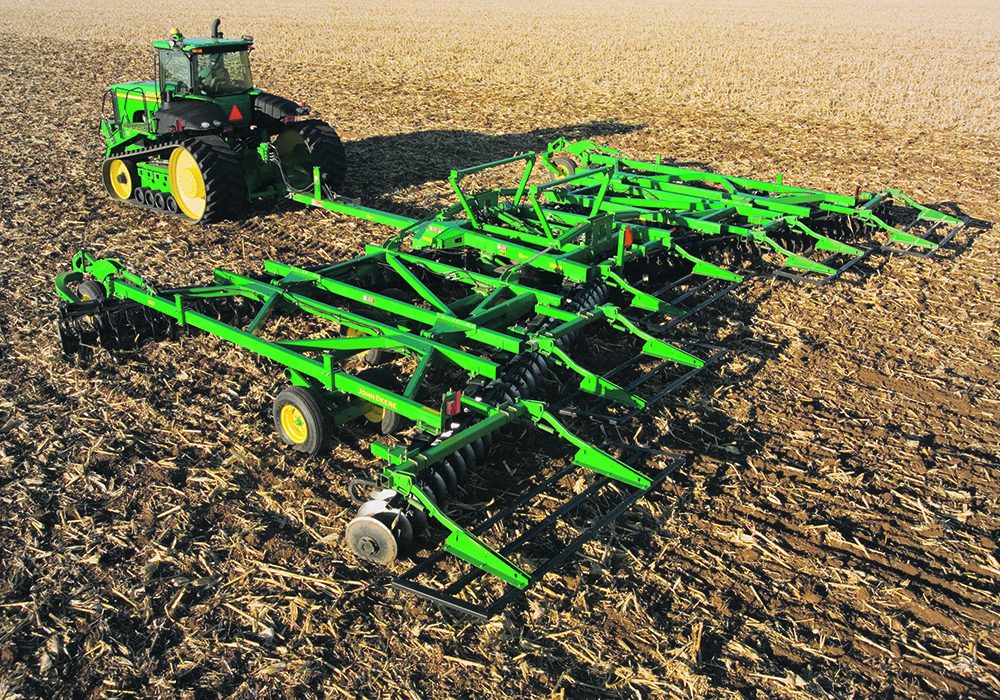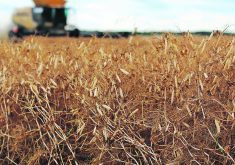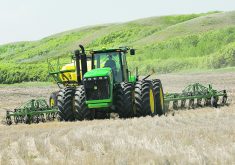Vertical tillage, sub-soiler debated | Zero-till farmer says the Smart-Till penetrates the soil and fractures it sideways
MINOT, N.D. — Dustin Williams sat down recently during the Manitoba-North Dakota Zero Tillage Farmers Association’s annual meeting to talk about a topic usually forbidden at zero till conferences.
Williams, a former president of the association, bought a Smart-Till vertical tillage implement in 2012 to break up compacted soil on his farm.
“I have compaction in the six inch to 10 inch (soil depth) on most of my land,” said Williams, who farms 4,200 acres near Souris, Man.
“My roots are moving sideways when they get to it. In some cases, I can’t even get a sunflower root down through it. It’s pretty heavy compaction…. At a zero till conference to talk about tillage of any type is sacrilegious, to say the least, but losing money is no fun, either.”
Read Also

Growing garlic by the thousands in Manitoba
Grower holds a planting party day every fall as a crowd gathers to help put 28,000 plants, and sometimes more, into theground
Williams said he would rather not till his land because his family has been practicing conservation tillage for more than two decades.
Still, lacking solutions to his compacted soil problem, Williams felt compelled to try vertical tillage.
“The problem with having a name like zero till farmers association, it kind of (corners you) into never (tilling) again,” Williams said.
“How do you fix a compaction zone from six to 10 inches?”
Marla Riekman, a Manitoba Agriculture land management specialist, said the Smart-Till is slightly different than other vertical tillage equipment because it cuts deeper and almost acts like a soil aerator.
However, she said that while vertical tillage implements are suited for crop residue management, they will not break up compacted soil.
With the exception of anecdotal evidence, she added, there is no proof that vertical till equipment will alleviate compacted soil problems.
“No, nothing that I’ve seen, and nothing that a lot of researchers I’ve talked to have seen,” said Riekman, who spoke at the zero tillage workshop held in Minot Jan. 6-8.
Riekman said manufacturers of vertical tillage equipment often say the implements will crack and rupture the soil below the depth of the steel, but she remains skeptical.
“Because you’re cutting that two inches, that’s the fracturing I think they were originally talking about,” she said.
“But it gets turned into (that) it will fracture the soil below the coulter. Say if you run it at two inches, it will fracture down to four… because it bounces along as it’s pulled through the soil and will crack it below. Is that what they are referring to?”
Riekman said vertical tillage equipment such as coulters are better residue management tools than soil management tools.
Instead of using a cultivator to break up straw, growers who want to move toward conservation tillage could use vertical tillage for that task.
“Maybe it has a benefit to do a light residue management … without doing a lot of damage to the soil below it,” she said.
Les Hill, program director for agricultural and bioresources with the Prairie Agricultural Machinery Institute, said a variety of vertical tillage implements are available, and it’s difficult to generalize.
“But if they’re talking about that top layer (of soil), that’s not going to have much effect on compaction.”
Hill said farmers need implements to smooth out the soil surface when the land becomes rutted from sprayer tracks and other equipment during wet years.
“Last year we found the fields, after seeding when there was pretty reasonable moisture in the spring, then late in the summer there were virtually no heavy rains … the ridges were just like cement. So the top was very, very hard,” he said.
“Farmers are saying they don’t want to go back to tillage, but they want to level that top layer off. That’s where some of these vertical tillage machines are being advertised as vertical tillage, but they’re more like a surface prep.”
Williams conducted strip trials with a sub-soiler before buying his Smart-Till implement and found that it boosted canola yields by five bushels per acre.
However, he said the sub-soiler used too much fuel and didn’t make sense for his farm. Instead, he decided to go with the Smart-Till.
“It reminds you of a roto-tiller, with straight tines on it,” he said.
“As it rolls along it penetrates the ground with the spike and fractures it sideways a little bit, then follows behind with rolling harrows…. This was a cheaper alternative than subsoiling.”
Williams said soil compaction is a significant and perhaps unrecognized problem for many growers in Manitoba.
He would like to see more research on vertical tillage so that producers have more information on what it can and cannot do.
“Before every farmer goes out and buys a $100,000 vertical till machine, we need to know whether it’s going to help us,” he said.
Hill said PAMI isn’t researching the efficacy of vertical tillage equipment on soil compaction, but it might consider doing so if growers are interested.
Riekman said Manitoba Agriculture has initiated a couple of projects on vertical tillage, but researchers are playing catch-up.
“We’re getting a lot of questions (from growers),” she said.
“It’s almost like we’re getting behind the times because farmers are going out and buying the equipment.”
Riekman said producers who own a vertical tiller shouldn’t use it on the entire field.
Instead, they should manage part of a field with vertical tillage and the other part without and then compare the results.






